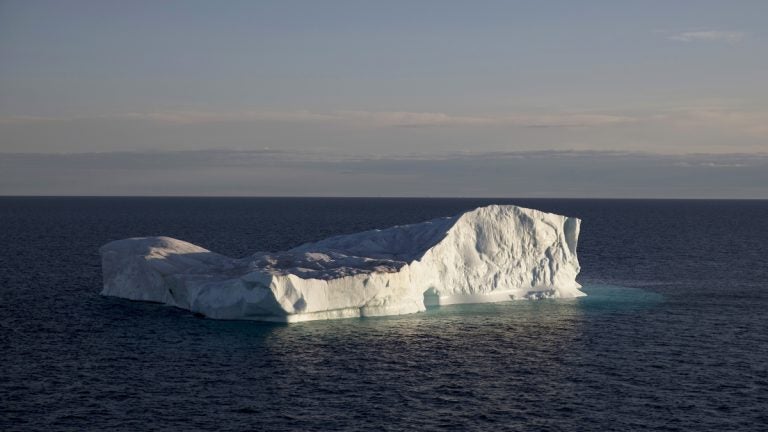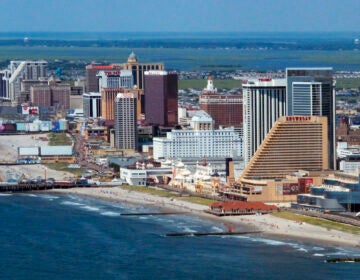Op-ed: N.J.’s next governor can make a real difference on climate change

An iceberg floats in Baffin Bay in the Canadian Arctic Archipelago, Tuesday, July 25, 2017. The iceberg calved off a glacier from the Greenland ice sheet, the second largest body of ice in the world which covers roughly 80 percent of the country. (David Goldman/AP Photo)
Our next governor has a tremendous opportunity to put New Jersey on track to meet its statewide greenhouse-gas limits and, in doing so, provide our residents with the benefits that come from science-informed climate-change policy, including clean air, improved public health, consumer savings, creation of jobs in innovative technology, and safe, vibrant communities.
Ten years ago, New Jersey enacted the Global Warming Response Act that set statewide limits to reduce greenhouse-gas emissions in the Garden State to 1990 levels by 2020 and to further reduce emissions 80 percent from 2006 levels by 2050.
Meeting the 2050 limit is an essential step toward the goals of the 2015 Paris Agreement, in which nearly all the countries of the world have committed to prevent the worst risks of climate change by limiting global warming to below two degrees Celsius.
Under current policies, New Jersey is projected to fall very short of the 2050 limit, which equals approximately 75 percent reduction from today’s levels.
A new report from Rutgers University, “An Examination of Policy Options for Achieving Greenhouse Gas Emissions Reductions in New Jersey,” highlights benefits that other states are gaining through adoption of notable climate-change policies, while pointing out existing authority that a new governor can use to get New Jersey back on track to meet its 2050 limit.
A time for action
Now is the time for our new governor to take decisive climate-change action immediately upon taking office. As we often hear, addressing climate change is a marathon, not a sprint. Achieving a 75 percent reduction in our emissions by 2050 means we need to get started now, articulate a vision and act.
We need to consider the costs rising sea levels, temperature extremes, and changes in precipitation have on public health, agriculture, roads, bridges and rail lines, electricity infrastructure, and water supply, and we need to consider those “social costs” in our planning, funding, and decision making. We need to further incentivize energy efficiency and deployment of renewable energy, including solar and offshore wind.
Now is the time for New Jersey to offer consumer incentives for purchase of electric vehicles, making sure that our building codes are “EV-ready,” and authorizing utilities to expand the state’s EV charging infrastructure.
New Jersey stands to benefit greatly by joining with our neighboring states to implement programs that attract clean-energy and clean vehicle technologies to our region including rejoining the Regional Greenhouse Gas Initiative (RGGI) and working with other states to explore cost-effective ways to “decarbonize” our transportation sector, the largest contributor to greenhouse gas emissions in New Jersey.
The next governor has the opportunity to work in partnership with the state’s Metropolitan Planning Organizations, counties, and municipalities to promote land-use strategies that support mass transit and walkable, bikeable communities, and we need to renew efforts to restore natural resources, including coastal wetlands and forests, which collect and store carbon dioxide.
Given President Donald Trump’s recent decision to withdraw the federal Flood Risk Management Standard, New Jersey’s next governor can act to strengthen standards and protect New Jersey’s people, communities, and infrastructure from increased extreme-flood hazards.
We suggest the next governor adopt the scientific guidance issued in November 2016 by the New Jersey Climate Adaptation Alliance regarding sea-level rise and changes in coastal storms to inform state and local planning and consult with the science community to develop similar guidance to address other changing climate conditions, such as temperature and precipitation.
New Jersey has had a strong history of being on the forefront of enacting policies to protect the state’s natural resources, communities, and residents from environmental threats. Given rollbacks in climate-change protections at the federal level, now is the time for New Jersey to adopt sound policies to address the sources of climate change, while also making our state more healthy, prosperous. and resilient.
___________________________
James J. Florio served as the 49th governor of New Jersey from 1990 to 1994, and was a member of the United States House of Representatives for 15 years between 1975 and 1990.
Thomas H. Kean served as the 48th governor of New Jersey from 1982 to 1990. In 2002, he was appointed by then-President George W. Bush to head the National Commission on Terrorist Attacks Upon the United States (the 9/11 Commission).
NJ Spotlight, an independent online news service on issues critical to New Jersey, makes its in-depth reporting available to NewsWorks.
WHYY is your source for fact-based, in-depth journalism and information. As a nonprofit organization, we rely on financial support from readers like you. Please give today.




